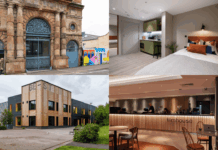
By Alasdair Rankin, MD, Aitken Turnbull Architects
WE know that our built environment matters, however very often we downplay its importance and treat environments as neutral as if they are simply a setting for our day to play out.
There are studies across multiple sectors and building types that demonstrate that the environments we inhabit directly impact us as humans. Education, workspace and healthcare all show measurable benefits when the environment is considered as a key part of the process.
At a wider level providing housing and communities that engage and embrace life and the people who live there, has been proven to build stronger and more caring communities.
In education settings we are now used to seeing the design of buildings being driven by a particular pedagogy, rather than a simple assumption that all teaching takes place in a ‘traditional’ classroom setting. The rise of forest schools and nurseries has further challenged the traditional approach to education buildings. The move, even in primary schools, to a more collegiate environment with forum spaces enhancing the shared experience mirrors the move to an inclusive focus in educational thinking.
Those of us involved in workspace are used to advising clients to consider their buildings as a member of the team, just as much as having the wrong characters in a team will impact on peoples experience of their workspace so will having the wrong workspace.
Most of us are now convinced that the future of successful workspace is in the provision of compelling spaces that draw team members in. We’ve moved beyond the early dot com bubble where a compelling workspace had beanbags and a football table. Now we know that great environments are about choice, community, engagement, daylight nature and inclusion.
In healthcare settings we know that a patients recovery journey is impacted – both positively and negatively – by the environment. Access to daylight, control of their own environment, spaces that bring joy and positivity all benefit in recovery and relaxation.
Healthcare environments are naturally often stressful. The architecture cannot remove the stress associated with a hospital visit or an unwelcome diagnosis, but it can help to provide comfort and relaxation, mitigating the associated stress points of orientation, welcome and crucially returning control – something so often stripped away by an unexpected diagnosis.
The provision of art to provide engagement and distraction as well as introducing beauty into challenging environments has also been proven to have a positive impact on patients’ treatment journeys.
As those who commission, design and deliver these environments we know that the school children and university students of five or ten years ago are now the office workers, and we are all patients in the healthcare sector.
The changes and developments in a single sector cannot be confined to one sector. We must continue to learn from developments across the built environment to understand and improve the spaces and environments we provide.











